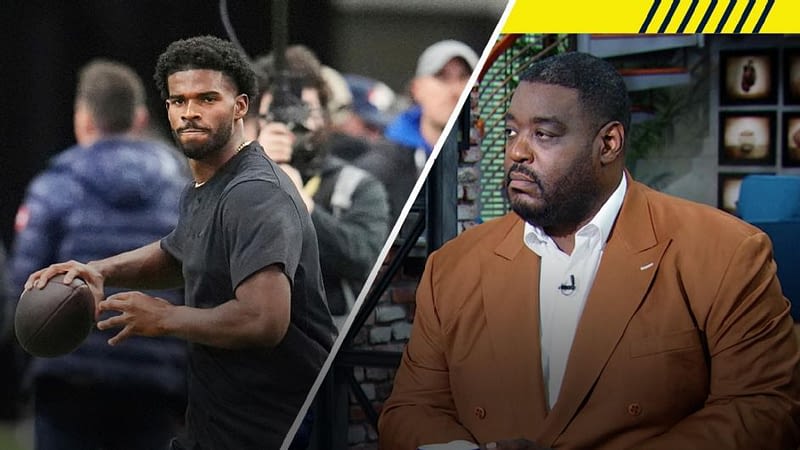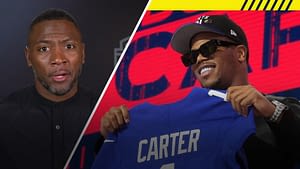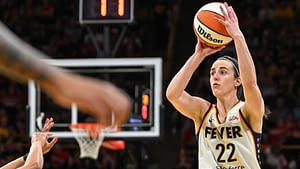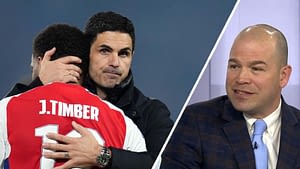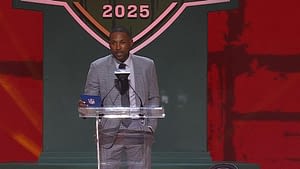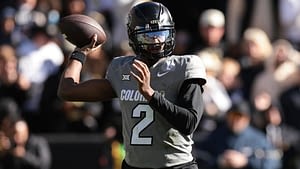Shedeur Sanders: A New Chapter Begins in Cleveland
BEREA, Ohio — Just three days after the unexpected turn of events that saw him fall to the fifth round in the 2025 NFL draft, Cleveland Browns quarterback Shedeur Sanders was already back in action, getting acclimated to his new NFL surroundings.
Sanders, who had been in Canton, Texas, during the draft, made his way to Cleveland and was soon spotted on a hill, dressed in a black T-shirt, gray shorts, and a pair of Nike Air DT Max ’96s. In a video clip shared on X, Sanders was seen shuffling sideways up the incline, reminiscent of a basketball player defending a ball handler, before pivoting and sprinting to the top.
Fast forward a few days, and Sanders was on a blue, indoor practice field in a Cleveland suburb. Wearing a white, long-sleeve shirt and black shorts, he called for an under-center handoff with a commanding cadence, rolled to his left, and launched passes to a group of volunteer pass catchers, all while music blared throughout the training facility.
These individual workouts, away from the prying eyes of the public and media, were just the beginning. Sanders was gearing up for his first NFL practice, a significant milestone in his professional journey.
On Friday, Sanders will take his first steps in his pro career as the Browns kick off a three-day rookie minicamp. The former Colorado star will be joined by his fellow draftees, undrafted rookies, and tryout players, all eager to make a strong impression and secure their spots on the team.
Despite being a fifth-round pick, Sanders arrives at the camp with a spotlight that far exceeds his draft position. His celebrity status as the son of Pro Football Hall of Famer Deion Sanders, his transformative success at two college programs, and his surprising draft slide have all contributed to the intrigue surrounding him.
In Cleveland, a franchise that hasn’t seen a Pro Bowl quarterback since Derek Anderson in 2007, Sanders is expected to have a shot at competing for the starting job. However, he faces several challenges, including a crowded quarterback room, a tendency to take ill-advised sacks, and the historical difficulty of fifth-round picks becoming successful quarterbacks, let alone Week 1 starters.
But Sanders is ready for the challenge. “I’m a Sanders,” he said after being selected 144th overall in the draft. “So it’s always going to be expectations regardless of what pick I am.”
Sanders’ Ambitious Quest
Sanders is attempting to achieve something only Dallas Cowboys quarterback Dak Prescott has managed in the past 15 years: turning a Day 3 draft slot into a Week 1 starting position as a rookie. Only four men have done this since 1967, and Sanders hopes to join their ranks.
During the draft, Browns general manager Andrew Berry traded Cleveland’s 166th and 192nd picks to move up and select Sanders 144th overall. Berry, known for his value-conscious approach, was enticed by Sanders’ talent, even after selecting former Oregon quarterback Dillon Gabriel two rounds earlier.
“[Sanders is] a guy that we think can outproduce his draft slot,” Berry said.
Prescott, a fourth-round selection (135th overall) by Dallas in 2016, had a unique path to starting as a rookie. Incumbent starter Tony Romo was sidelined by a back injury, and backup Kellen Moore broke his leg in training camp. Prescott went on to win 13 games and NFL Rookie of the Year honors, launching a career that includes three Pro Bowl selections and a second-place MVP finish in 2023.
The odds of fifth-rounders starting their team’s first game are even slimmer. According to Elias Sports Bureau, only four quarterbacks selected in the fifth round or later have started their team’s season opener as rookies: Randy Hedberg (Tampa Bay Buccaneers, 1977), James “Shack” Harris (Buffalo Bills, 1969), Dan Darragh (Buffalo Bills, 1968), and Dewey Warren (Cincinnati Bengals, 1968).
With 2024 starter Deshaun Watson expected to miss a significant portion of the 2025 season due to a right Achilles injury, Sanders has a chance to emerge from a quarterback room that includes Joe Flacco, Kenny Pickett, and Gabriel. If he succeeds, he would be the first fifth-round quarterback in the common draft era to start his team’s season opener as a rookie.
Just as rare is the number of quarterbacks drafted after the third round who become productive starters for multiple seasons. According to ESPN Research, only nine such quarterbacks have made multiple Pro Bowls, including seven-time Super Bowl winner Tom Brady, a sixth-round pick. The most recent was Prescott.
Mark Brunell, the 118th pick of the 1993 draft, is the only quarterback drafted in the fifth round in the past 40 years to win at least 10 games as a starting QB in the NFL.
The lack of immediate playing time and long-term success for late-round quarterbacks is expected, as these slots are usually reserved for developmental passers or players expected to start as backups.
However, in Cleveland, Sanders joins a QB room with no clear front-runner as the offseason workout program begins. Flacco, 40, started the 2024 season as the Indianapolis Colts’ backup to Anthony Richardson before making six starts. Pickett, the 20th pick in the 2022 draft, was Jalen Hurts‘ backup with the Super Bowl champion Philadelphia Eagles. Gabriel, like Sanders, is a rookie adjusting to the NFL and was expected to be a Day 3 selection, not the 94th overall pick.
“We expect every player to compete,” Berry said when asked about Sanders’ opportunity to become the starter. “Simple as that.”
Sanders’ College Success and Challenges
Former Colorado wideout LaJohntay Wester recalled a play that best described Sanders during their time as teammates. He mentioned Sanders’ back-shoulder fade to receiver Travis Hunter for a touchdown in the Buffaloes’ 31-26 season-opening victory over North Dakota State last August.
On the play, Sanders took a shotgun snap, quickly pivoted to Hunter, and placed the ball perfectly on the inside shoulder of the wideout, who made an acrobatic catch despite tight coverage.
Sanders’ draft slide was attributed to a lack of elite physical traits and a rocky predraft process. However, the play Wester referenced showcased Sanders’ best traits: accuracy and confidence within the pocket, which could help him stand out in OTAs and training camp.
In his final college season, Sanders ranked first in completion percentage (74%) and had a 6.5% off-target rate, the third-lowest in the FBS. Though 24.6% of his passes were screen routes, Sanders excelled on deeper attempts, completing 54.0% of passes traveling at least 10 air yards, the ninth-highest rate in the country (Gabriel was second at 59.7%).
“Decision-making. That’s the biggest and best thing you can do as a quarterback,” Sanders said at the Shrine Bowl. “That’s what my skill set is. … Decision-making at the quarterback position for my skill set and what I like to do — sit in the pocket and throw it — that’s the best attribute.”
Sanders has also protected the ball well, with a 2.1% interception rate tied for 36th lowest among 124 qualifying FBS quarterbacks. He cited his experience with six offensive coordinators in four college seasons as beneficial to his NFL transition. However, one area for improvement is his tendency to take sacks.
Nobody in the FBS took more sacks over the past two seasons than Sanders, who was sacked 94 times, 16 more than any other quarterback. At Colorado, Sanders was protected by a lackluster offensive line and lacked a strong running game. Despite attempting screen passes at a high rate, Sanders’ average time to throw last season was 2.96 seconds, ranking 110th in the FBS and above the national average of 2.76.
“We view him as a highly accurate pocket passer,” Berry said. “He does a really good job of protecting the ball. He has enough of the physical characteristics, whether it’s arm strength or mobility. Like all young players, there are things to improve. I think probably much has been said about the number of sacks he’s taken. Some of that is environment, and some of that is improvement on his end, for sure. But he has probably a little bit more of a, call it retro or classic style of play.”
During the predraft cycle, a current NFL quarterbacks coach told ESPN that decision-making within the pocket is crucial for a rookie passer entering the league.
- “Being behind the sticks in the NFL is detrimental to your chances of scoring,” the coach said. “I think if you have one negative play on the NFL drive, your chances of scoring on that drive go down to 15%. I don’t think it’s the same in college just because these guys are explosive and the spectrum of talent is so much deeper. …
- “You can be behind the sticks and end up scoring still, but that’s not the case in the league because everyone’s just really good. I think, one, is the decision-making, just making sure they take calculated risks and controlled aggression. And then I think for the most part it’s being comfortable playing inside of a messy pocket, because the defensive line is so much more aggressive and athletic, it’s just being able to operate in a tiny area of space.”
The coach added that both can be honed and developed through continued practice drills and reps.
“Sometimes I was trying to make too much happen,” Sanders said at the scouting combine in February. “So that just comes from a mindset of do-or-die mentality, to where you’re going to succeed and not succeed. And sometimes I got caught up playing hero ball, but I understand where I messed up, and now I’m going to fix it at the next level.”
Looking Ahead: Sanders’ Opportunity
When Sanders takes the field at the Browns’ practice facility for the first time on Friday, he won’t be the face of the franchise but a late-round pick who must outplay his competition to become a starter or top backup in the coming months.
Browns coach Kevin Stefanski mentioned that practice reps might not be evenly distributed among the quarterbacks but will be divided in a way that is “fair to each player and fair to the team.”
After Sanders’ long wait on draft weekend, he expressed gratitude to the Browns’ organization for the opportunity, one he intends to seize in the coming months.
“We did tell him that it really doesn’t matter where you’re picked,” Berry said. “It’s what you do from that point forward, because that’s the reality for all the guys that we selected this weekend.”
Originally Written by: Daniel Oyefusi
